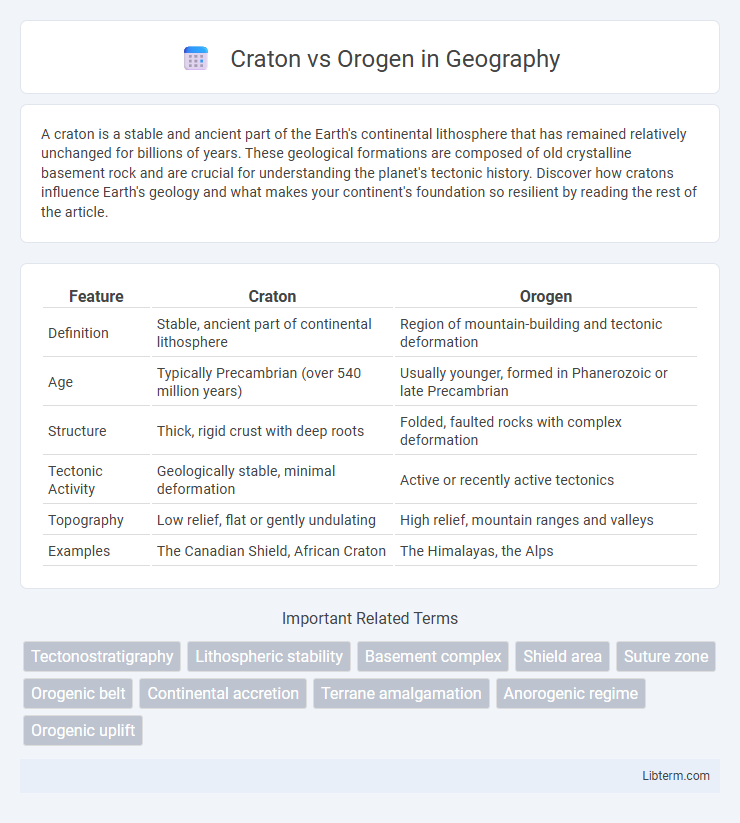A craton is a stable and ancient part of the Earth's continental lithosphere that has remained relatively unchanged for billions of years. These geological formations are composed of old crystalline basement rock and are crucial for understanding the planet's tectonic history. Discover how cratons influence Earth's geology and what makes your continent's foundation so resilient by reading the rest of the article.
Table of Comparison
| Feature | Craton | Orogen |
|---|---|---|
| Definition | Stable, ancient part of continental lithosphere | Region of mountain-building and tectonic deformation |
| Age | Typically Precambrian (over 540 million years) | Usually younger, formed in Phanerozoic or late Precambrian |
| Structure | Thick, rigid crust with deep roots | Folded, faulted rocks with complex deformation |
| Tectonic Activity | Geologically stable, minimal deformation | Active or recently active tectonics |
| Topography | Low relief, flat or gently undulating | High relief, mountain ranges and valleys |
| Examples | The Canadian Shield, African Craton | The Himalayas, the Alps |
Introduction to Cratons and Orogens
Cratons represent the stable, ancient cores of continents composed of old, crystalline basement rocks that have remained relatively unchanged for over a billion years. Orogens are regions of intense deformation and mountain-building resulting from tectonic plate collisions, characterized by folded and faulted rock structures. Understanding the contrast between cratons and orogens is essential for studying Earth's geological history and plate tectonic processes.
Geological Definitions: What are Cratons and Orogens?
Cratons are stable, ancient parts of the continental lithosphere that have remained relatively unchanged for billions of years, characterized by thick, rigid roots extending deep into the mantle. Orogens are zones of mountain-building formed by tectonic plate collisions, featuring deformed rocks, folded strata, and metamorphic belts that reflect intense compressional forces. The contrasting geological definitions distinguish cratons as tectonically inactive cores, while orogens signify dynamic, orogenic belts undergoing active deformation and crustal thickening.
Formation Processes: Cratonization vs Orogenesis
Cratonization forms stable continental cores through prolonged cooling and thickening of the lithosphere, creating ancient, rigid crust resistant to deformation. Orogenesis involves dynamic tectonic processes such as plate convergence, subduction, and continental collision, producing mountain ranges by intense deformation, metamorphism, and crustal thickening. These contrasting formation processes highlight the craton's stability versus the orogen's active geological evolution.
Age and Evolution of Cratons vs Orogens
Cratons are ancient, stable parts of the continental lithosphere, often exceeding 2.5 billion years in age, formed during the Archean and Proterozoic eons and characterized by little tectonic activity since their stabilization. Orogens are younger, tectonically active mountain belts created by plate convergence and collision, ranging from hundreds of millions to tens of millions of years old, with ongoing structural deformation and metamorphism. The evolution of cratons involves long-term thermal and mechanical stabilization, whereas orogens evolve through episodic mountain building, crustal thickening, and subsequent erosion phases.
Structural Characteristics: Stability and Deformation
Cratons exhibit long-term structural stability characterized by thick, rigid lithospheric roots resistant to deformation, preserving ancient geological formations. Orogens display intense deformation patterns including folding, faulting, and metamorphism due to active tectonic collision and mountain-building processes. The contrasting structural behavior highlights cratons as stable continental interiors while orogens represent dynamic zones of crustal thickening and tectonic reworking.
Tectonic Settings: Where Cratons and Orogens Occur
Cratons are stable, ancient parts of the continental lithosphere found in the interiors of tectonic plates, often characterized by thick, cool, and rigid lithospheric roots. Orogens form at convergent plate boundaries where tectonic plates collide, leading to mountain building through processes such as subduction and continental collision. These orogenic belts are typically located along active plate margins and are associated with seismic activity and crustal deformation.
Economic Importance: Mineral Resources in Cratons and Orogens
Cratons are rich in stable, ancient mineral deposits, including significant reserves of gold, diamonds, and base metals, contributing substantially to global mining industries. Orogens, formed by tectonic plate collisions, often host valuable, structurally complex mineral deposits like copper, lead, zinc, and rare earth elements due to intense metamorphic and hydrothermal processes. The economic importance of these regions lies in their distinct yet complementary mineral wealth, driving exploration and extraction in global resource markets.
Notable Examples Around the World
The Canadian Shield and the Siberian Craton are prime examples of stable ancient cratons characterized by their extensive, exposed Precambrian rocks and minimal tectonic activity. In contrast, the Himalayan and Alpine orogenies represent active mountain-building zones formed by continental collision and intense deformation. These orogenic belts are marked by high seismicity and ongoing crustal uplift, contrasting with the tectonic stability of cratons.
Cratons and Orogens in Plate Tectonics Theory
Cratons are stable, ancient parts of the continental lithosphere that form the core of tectonic plates, characterized by thick, rigid lithospheric roots resistant to deformation. Orogens, by contrast, are regions of intense deformation created by plate convergence, where mountain building occurs through processes such as subduction, collision, and crustal thickening. In Plate Tectonics Theory, cratons represent the tectonic stability and preservation of continental interiors, while orogens illustrate dynamic mountain-building events driven by plate interactions.
Key Differences and Summary Table
Cratons are ancient, stable parts of the continental lithosphere, typically characterized by low seismic activity, thick lithospheric roots, and minimal tectonic deformation, whereas orogens represent regions of intense mountain-building with active tectonic processes, high seismicity, and significant crustal thickening. Key differences include cratons' composition of old, metamorphosed continental crust versus orogens' younger, deformed rock assemblages formed through plate convergence and collision. The summary table contrasts cratons' stability, age (often over 2.5 billion years), and limited deformation against orogens' dynamic evolution, relatively younger geological age, and ongoing tectonic activity.
Craton Infographic

 libterm.com
libterm.com